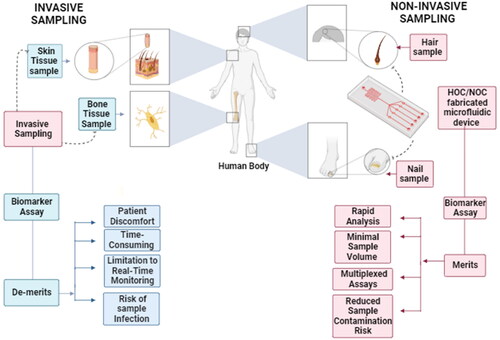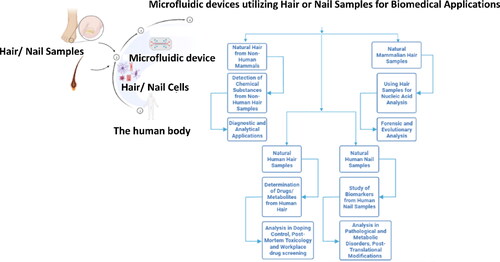Figures & data
Figure 1. Hair and nails for the construction of microfluidic organ-on-a-chip platforms and their subsequent utilization in a range of biomedical applications.

Table 1. Hair or nail-fabricated micro/nanofluidic devices.
Figure 2. Schematic illustration of the pioneering fabrication of a microfluidic platform from mammalian hairs and its subsequent application in microwire synthesis, immunoassays, cell sorting and manipulations. Adapted with permission from Ref. [Citation67].
![Figure 2. Schematic illustration of the pioneering fabrication of a microfluidic platform from mammalian hairs and its subsequent application in microwire synthesis, immunoassays, cell sorting and manipulations. Adapted with permission from Ref. [Citation67].](/cms/asset/3efa4561-ab14-49a3-9ba9-0d180331c638/batc_a_2291825_f0002_c.jpg)
Figure 3. Diagrammatic depiction of the process of designing a nanofluidic device from a human nail plate, succeeded by its detailed characterization to demonstrate nanofluidic phenomena, such as Perm-selectivity. Adapted from Ref. [Citation69].
![Figure 3. Diagrammatic depiction of the process of designing a nanofluidic device from a human nail plate, succeeded by its detailed characterization to demonstrate nanofluidic phenomena, such as Perm-selectivity. Adapted from Ref. [Citation69].](/cms/asset/f2614366-e47c-4933-94bd-7346ac0e9432/batc_a_2291825_f0003_c.jpg)
Figure 4. Simplified demonstration of a novel two-color lithography process of constructing arrays of magnetically actuated artificial cilia with desired geometrical and mechanical properties. Adapted with permission from Ref. [Citation88].
![Figure 4. Simplified demonstration of a novel two-color lithography process of constructing arrays of magnetically actuated artificial cilia with desired geometrical and mechanical properties. Adapted with permission from Ref. [Citation88].](/cms/asset/5be69706-b424-4f42-b8a2-b8de24921114/batc_a_2291825_f0004_c.jpg)
Figure 5. Fabrication scheme of a dynamically perfused chip-based bioreactor capable of prolonging the maintenance and testing periods of ex-vivo human skin and follicular extracts for a range of biomedical applications. Adapted with permission from Ref. [Citation100].
![Figure 5. Fabrication scheme of a dynamically perfused chip-based bioreactor capable of prolonging the maintenance and testing periods of ex-vivo human skin and follicular extracts for a range of biomedical applications. Adapted with permission from Ref. [Citation100].](/cms/asset/3cca62d0-7336-4190-9406-7207e9b52b1d/batc_a_2291825_f0005_c.jpg)
Figure 6. Microfluidic hair and nail-on-a-chip devices as noninvasive and reliable alternatives to conventional sampling in a variety of diagnostic applications.

Table 2. Hair/nails as biomarkers in microfluidic assays.
Figure 7. Diagrammatic illustration of a simple, multilayered paper-based microfluidic chip with a manually controllable flap for the noninvasive sample preparation and detection of clenbuterol from swine hair samples using SERS. Adapted with permission from Ref. [Citation112].
![Figure 7. Diagrammatic illustration of a simple, multilayered paper-based microfluidic chip with a manually controllable flap for the noninvasive sample preparation and detection of clenbuterol from swine hair samples using SERS. Adapted with permission from Ref. [Citation112].](/cms/asset/0dc5f768-2ca9-4371-b489-deef42891138/batc_a_2291825_f0007_c.jpg)
Figure 8. Operational overview of a chelex-based microfabricated device for on-chip purification and amplification of DNA (deoxyribonucleic acid) from human hair in integrated flow-through polymerase chain reaction (PCR). Adapted from Ref. [Citation107].
![Figure 8. Operational overview of a chelex-based microfabricated device for on-chip purification and amplification of DNA (deoxyribonucleic acid) from human hair in integrated flow-through polymerase chain reaction (PCR). Adapted from Ref. [Citation107].](/cms/asset/88d201c8-1815-4547-9d18-4ad196c4f5c7/batc_a_2291825_f0008_c.jpg)
Data availability statement
No data was used for the research described in the article.